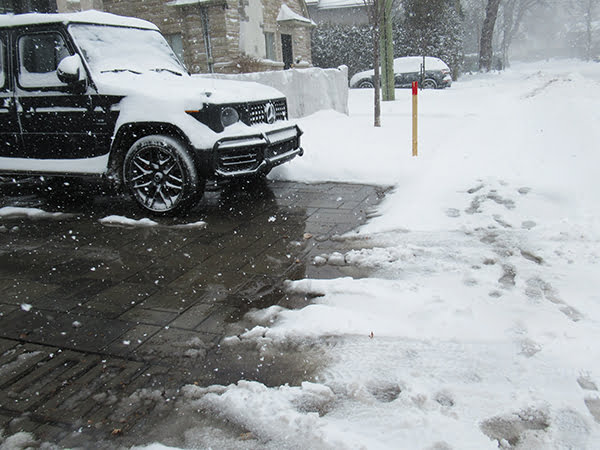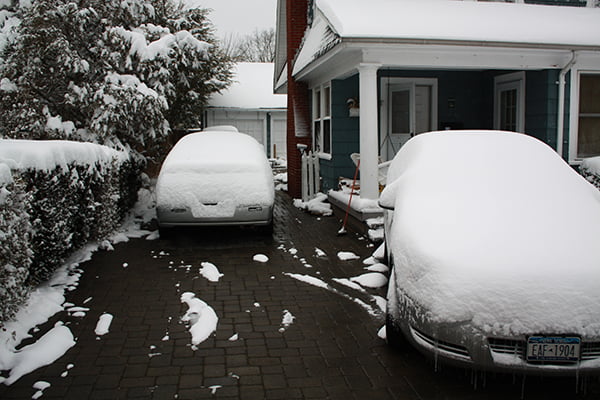A heated driveway system provides a convenient and efficient way to keep your driveway clear of snow and ice, making it easier and safer to navigate during the winter months. Not only can it eliminate the task of manual snow removal and save you time, but it can also increase the value of your home.
Before we get started, it's important to know the distinction between two different products that both melt snow and ice in your driveway: build in heated driveway system and portable heated driveway mats. Heated driveway mats are great options for cost-conscious shoppers that are not prepared to invest in a built-in system.
In this guide to heated driveways, we'll answer commonly asked questions to help you determine if a snow-melting system is a worthwhile investment for your property.
How does a heated driveway system work?
Before we get down to the details, it's important you have a clear understanding of how a heated driveway system works.
A heated driveway system uses a series of tubes or cables buried beneath the driveway's surface. These tubes or cables contain a circulating fluid, usually water or glycol, which is heated by an electric resistance heater or a boiler. The heat from the circulating fluid is then transferred to the driveway surface, melting snow and ice on contact. Some heated driveway systems also have a sensor that can detect the presence of moisture and automatically turn on the heating system when needed. The heated driveway system can typically be controlled by a thermostat, allowing the homeowner to set the desired temperature and customize the heating schedule to their needs.
What are the different types of snow melting systems?
There are several types of snow-melting heating elements available on the market, each with its own unique set of benefits and drawbacks:
Electric radiant heating system
With a radiant snow melting system, electric cables or mats installed beneath the driveway surface emit heat, resulting in easy operation and relatively low maintenance. However, it can be expensive to install and may not be as efficient as other heating methods in very cold climates. But radiant heat can help extend the life of concrete driveways and keep them from abrasive snow removal methods, chemicals and salt.
To comply with National Electric Code 426-13, an electric snow melting system requires purchasing a plaque to present beneath the driveway.
Hydronic system
A network of water pipes installed beneath the driveway provides more efficient and longer-lasting than electric radiant heating but can be more complex and costly to install. Initially, hydronic systems can cost 30% to 50% more than electric systems, but over time, they use less energy than their electrical counterparts.
Propane-powered
Natural gas heats the driveway through a network of tubes or plates beneath the surface. Though more affordable to install than electric or hydronic heating, they're often less energy-efficient and may require more frequent maintenance.

Source: Flickr
Do you need to heat your entire driveway?
Full-coverage heated driveway systems provide a consistent and reliable source of heat throughout the entire driveway surface. This means that no matter where you park or walk, you will have a warm and safe surface to stand on. By contrast, tire tracks only provide heat in the areas where your tires will be, and this can lead to uneven heating and potentially hazardous icy patches in other driveway areas. Overall, full-coverage heated driveway systems offer a more comprehensive and reliable solution for maintaining a safe and warm driveway in cold weather, as they heat the entire surface rather than just a small portion.
Can you add heat to an existing concrete or asphalt driveway?
Yes, it is possible to add heat to both concrete driveways and asphalt driveways. Several methods can be used to achieve this, including installing electric heating cables or radiant heat systems.
Electric heating cables are designed to be buried beneath the driveway's surface and connected to a power source to generate heat. Radiant heat systems transfer heat from a central boiler or water heater to the driveway through a series of tubes or pipes embedded in the pavement. Both of these options can effectively melt snow and ice on the surface of an existing driveway, making it safer and more convenient for vehicles to access.
However, it is important to consider the costs and logistical challenges associated with adding heat to an existing driveway. The installation process can be complex and may require professional assistance, which can increase the overall cost of the project. Additionally, the ongoing energy costs of maintaining the heating system may be a significant expense. It is important to carefully weigh the benefits of a heated driveway against the potential costs before deciding to install one.
How much electricity does a heated driveway use?
The amount of electricity a heated driveway uses depends on the size of the driveway, the type of heating system used, and how long it's used. On average, a heated driveway can use anywhere from 500 to 1,500 watts per square foot. A typical driveway can equate to several hundred dollars per month in electricity costs.
How much does a heated driveway cost to operate?
The operating costs of a heated driveway vary widely based on a number of factors, including weather severity, driveway size, the cost of electricity in your area, and the type of heating system you have installed.
To calculate the operating cost of a heated driveway, you will need to gather some information about your driveway and energy usage. First, measure the length and width of your driveway to determine its total square footage.
Next, decide the average temperature at which you plan to heat your driveway. This will help you determine how much energy your driveway will need to generate to maintain a comfortable temperature. You will also need to know the cost of electricity or natural gas in your area, as well as the efficiency of your heating system. Once you have this information, you can use this simple formula to calculate the operating cost of your heated driveway:
(Square footage of driveway X heating cost per square foot X number of heating hours per day) / heating system efficiency = Daily operating costs. For example, if your driveway is 1000 square feet, the cost of heating is $0.10 per square foot, and the heating system is 80% efficient, the operating cost would be ((1000 $0.10) 24) / 0.8 = $300 per day.
Concerned about the cost of a heated driveway? There are ways to minimize energy usage, such as using a thermostat to control the temperature and only turning the system on when necessary. It is important to consult with a professional and consider the additional monthly costs you'll have to pay before installing a heated driveway.

Source: Flickr
Heated Driveways Cost
The cost of installing a heated driveway varies significantly based on the following factors. But generally, the heated driveway costs can range anywhere from $10,000 to $20,000 or more:
Labor costs
Driveway size and configuration
Type of driveway heating system and quality
Additional features and customization requests
It is essential to do thorough research and get quotes from multiple contractors to determine the most accurate and cost-effective option for your specific situation.
Is a heated driveway worth it?
A heated driveway can be a luxurious and convenient addition to any home, but it is important to consider whether it is worth the investment. The biggest benefit of a heated driveway is that it can provide a safe and clear pathway to your home during inclement weather. No more shoveling or de-icing your driveway in the winter, as the heat will melt snow and ice as it falls. This can save time and effort, as well as prevent slips and falls. However, driveway heating systems can also be expensive to install and maintain. It requires an extensive electrical system and specialized materials, which can be costly. In addition, it will likely increase your energy bills as it will be using electricity to heat the driveway.

